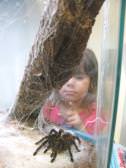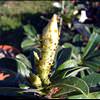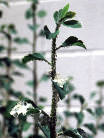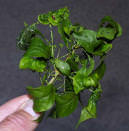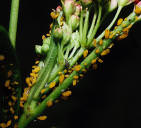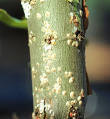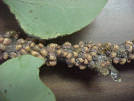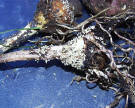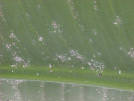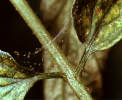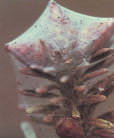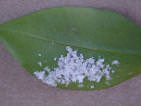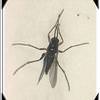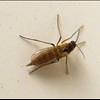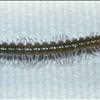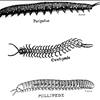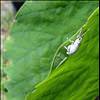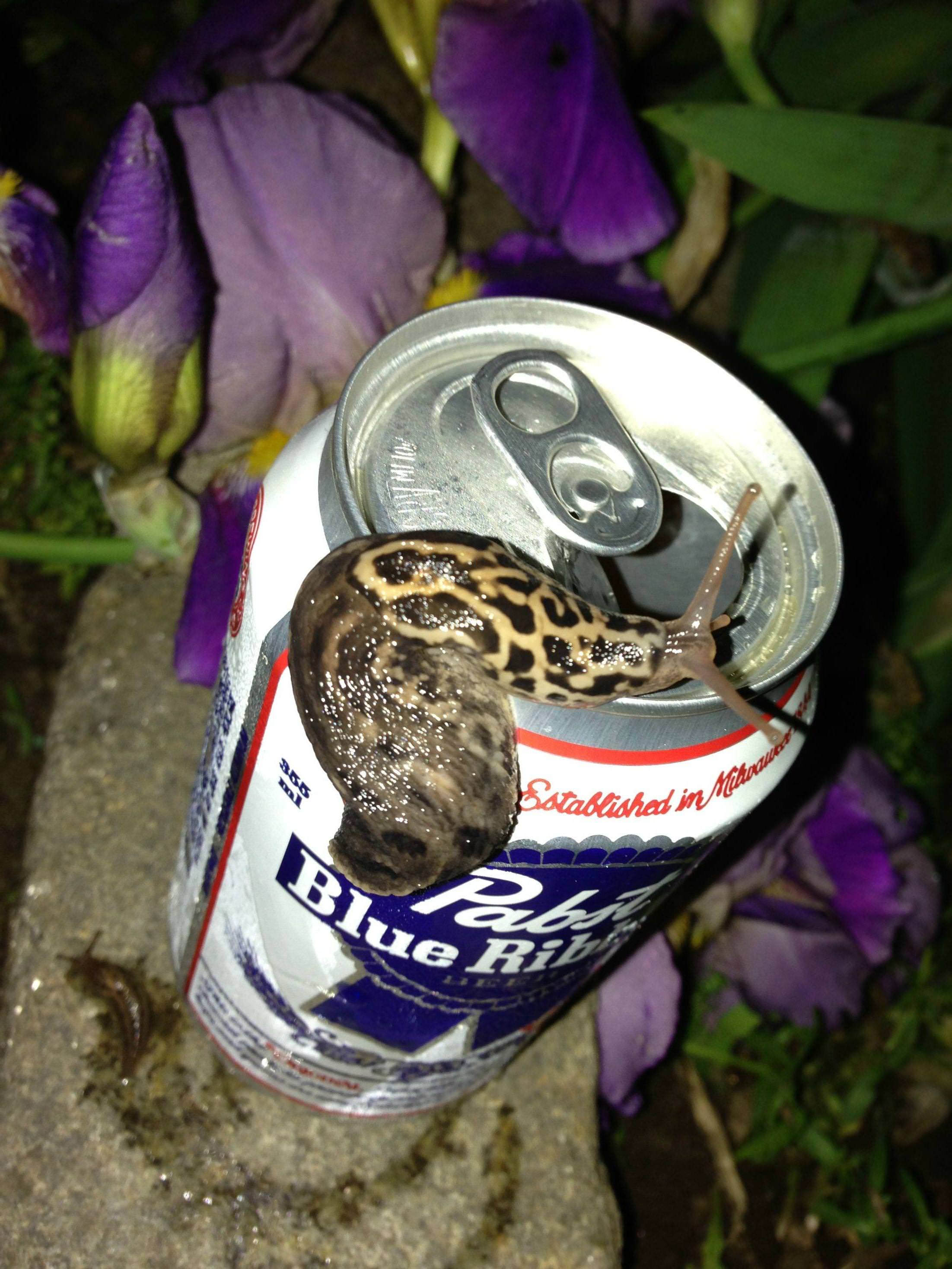This plant may be available to buy
Click the banana to see

|
Plant Pests |
click pic to enlarge There are over 1,000,000 named species of bugs worldwide. In fact, the sum of the weight of all insects = 300X the weight of all people in the world. Insects are super abundant and totally central to Nature's system Only less than 1% of insects do damage to plants ...and that damage is almost always slight and temporary until beneficial insects rebalance The point is insects are here to stay and outdoors, almost always "go away" by themselves However... Plants in your home are captives and must rely on you for all their care. Rule #1 is to provide proper care; food, water, light, soil and drainage Certain pests and some diseases can attack your house plants so rule #2 is to be vigilant for any signs of trouble The main pests are:
click pic to enlarge Click the picture above to see yellow and brown aphids in high rez
Above, the last picture above shows ants "farming" aphids. Ants protect the aphids (and also move them around) in order to "milk" the aphids of their sweet honeydew excretions, which ants eat. Attacking ants (where they live) is often necessary to keep down aphids. On the other hand, Mama aphid just flies in and deposits eggs outdoors. Mama is persistent and works hardest during dry spells
click pic to enlarge
click pics to enlarge ....but, keep in mind caterpillars = butterflies / garden
click pics to enlarge
click pics to enlarge Fungus gnats are not a hazard, but they are annoying. Control with pyrethrum spray on soil. Adult life cycle is only about one month Centipedes and millipedes are also soil insects and not a hazard either. Pick them off or spray with pyrethrum
click pic to enlarge Sri Lankin Beatle is new in South Florida. These pests love Bauhinia (Orchid trees) and chew the leaf edges. Notice in the left side of the picture above the round cut-outs eaten by this pest ...cosmetic disruption seems all they do. Control with Organicide and/or Sevin spray. Sri Lankin beetles will drop to the ground (to get away) as you disturb a leaf to look underneath to find them. If you do so gently, slowly, most do not drop. Persistance is the key. You should hunt these bugs daily lest they just multiply and spread
Sink/bury shallow bowls into your soil to match bowl rims with the level of your soil. Pour cheap beer into all of your bowls. Snails and slugs are attracted to beer and will crawl in and drown because the beer somehow removes their "slime" so they can't get out. Dispose of your slugs/snails then repeat by refilling bowls with beer. To go one step further, some birds will also eat your captured slugs if you have a way for your birds to see your offering
Cathy from Florida wrote in to say mothballs worked for her in keeping white flies away...
""
Keeping your plants clean, on a schedule, is the best way to thwart bugs. Regular washing with water will keep leaf pores clean and rinse away insects even before you see them. For small plants, rinse in the sink for 20-30 seconds or your bath tub and be sure to clean the stems, leaf axils and especially the undersides of all the leaves. For larger plants, use a sponge or soft cloth and wash all parts monthly or more often NEVER use commercial leaf "shine" products as these clog leaf pores and are very bad for all plants For sooty mold, first, consider WHY you have the fungus. Chances are you have your sun-loving plant in too much shade and/or too little air circulation. A general fungicide (read product labels) handles sooty mold, but not the problem of the wrong location for your plant Excess irrigation and/or sprinklers frequently hitting sun-loving plant leaves contribute to sooty mold, especially with poor air circulation Should you notice tiny webs at the underside of your leaves or in leaf axils, you could have spider mites. Wash by hand but use dish soap and water, about 1-2 tablespoons to the gallon is enough. Use warm water and wash thoroughly. If pests are seen or thought present, wash with dish soap weekly for 3-4 weeks You could also purchase an organic insecticidal soap instead of using your liquid dish soap. It is said that certain fatty acids in dish soap are not good for your plants and these have been removed in the organic formulation In general, soap treatments do not really work, except for only the most diligent plant lovers. We go with Pyrethrum spray or Sevin spray for almost all pests, except scale insects and ants For scale insects, horticultural oil is great. The oil covers and so smoothers the scales then they suffocate. Horticultural oil may have other names on the label. Look for the word "oil" then read the back to see if it's the stuff you want For mealy bugs, a dilute solution of water and rubbing alcohol sprayed on leaves will kill these pests. The bugs turn brown in color and you wipe them off. Be sure you use only a little alcohol. The alcohol approach can work against scales and aphids as well. We don't use the alcohol approach, however, because we rely on Pyrethrum spray for mealy bugs. The alcohol approach is OK, but the Pyrethrum works every time Other organic approaches include products with Rotenone and Pyrethrum. These are natural bug killers available at quality garden centers. Mix per directions and spray on your affected plants Nicotine spray can be effective. Buy some or soak a cigar in water for a few days. Dilute to the color of tea and spray Pepper spray is organic and can work for you. Indoors or outdoors, for beetles and some other bugs, get your sprayer and add about 1 teaspoon of liquid dish soap. Cover the top with cheesecloth or some other filter. Place 1-2 teaspoons dry cayenne pepper plus 1-2 teaspoons dry garlic power on top of your cheesecloth. Pour water gently over the top. After your jar is full, shake it a little then go spray the bad bugs. Plan on repeating the spray in 5 days. Maybe once again after that Wendy Goldberg, an M.S. in Chemistry, emailed us her personal organic home-made formula, especially for spider mites, although she says it works on the other soft bugs as well 6 tablespoons jalapeno pepper (the "nacho jalapenos" in a jar work fine). This provides capsaicin. 6 tablespoons minced garlic. This provides diallyl disulfide. 3 cups water. Blend in a blender. Strain through a fine sieve. Add 10 drops liquid dishwashing detergent. This acts as a surfactant (wetting agent) to get the toxins into the spiracles of the pests. Spray on pests. For a chemical agent, you can try Dexol indoors. This is a systemic product so apply to both the leaves and your soil. The plant will take up the chemical from the soil Outdoors for pests, you can try Orthene or Cygon per label directions. Both are chemical agents so be careful. Using Malathion has many effects, like killing bugs while also almost killing any plant you spray it on; defoliation is the usual afteramath. Malathion is also dangerous if you breathe it in. Don't use Malathion for anything For caterpillars, any product that has Bacillus thuringensis will work. Dipel is one brand name we see on shelves, but any competitor is OK. Spray Bacillus thuringiensis on leaves, caterpillars eat the leaves, the bacteria attack the stomach then kill the caterpillars For most bad bugs, we rely heavily on Pyrethrum... For aphids and many other pests except scale insects. Pyrethrum is organic, derived from chrysanthemum flowers, and is sold in a concentrate. A small capful in a pint of water in your sprayer knocks out the bad guys pronto. Pyrethrum concentrate is sold under a variety of names so read the label and try to buy pure pyrethrum concentrate Avoiding trouble before it starts Examine plants before you buy. Check out the both sides of the leaves and axils at the nursery. You're not trying for a perfect plant because some leaf browning or yellowing or spots is often natural but you sure can avoid bringing home unwanted pests Another good safety rule is to wash new plants (outdoors) before taking them into your home. Nurseries and retailers would never knowingly sell you infested plants, but it does happen A third safety rule is to gently un-pot your new plant to examine the soil and roots. For example, here in South Florida, ants in pots are pretty common. Do this examination at the nursery or retail garden center so you don't bring home problems lurking in the soil. If you're buying from a local nursery, ask the people there to un-pot your plant. Watch therm do it so you learn how Plant diseases are not generally seen indoors. In humid conditions or excess water, fungus can become a problem. Indoors for fungus, you can use Captan fungicide |
